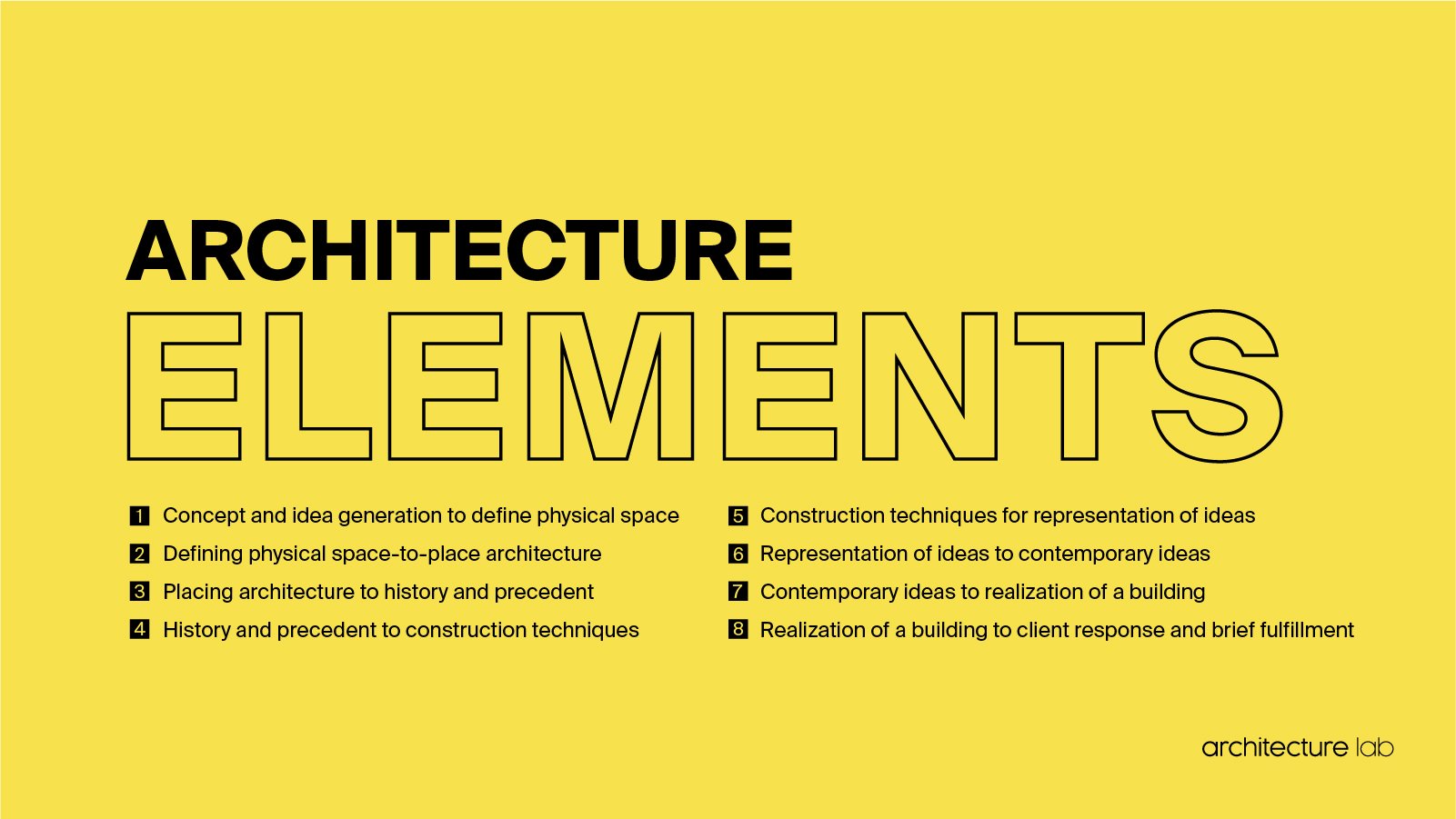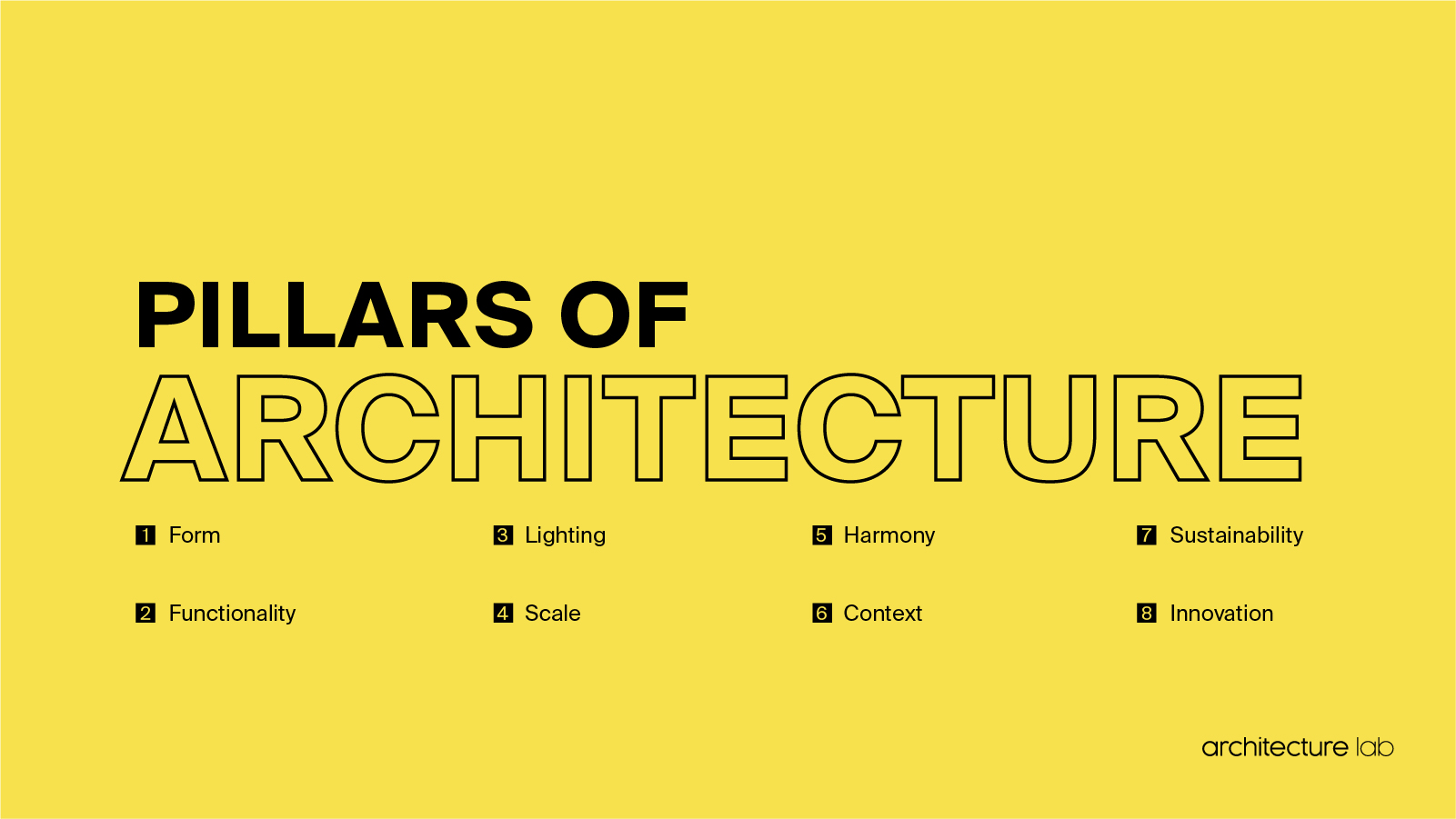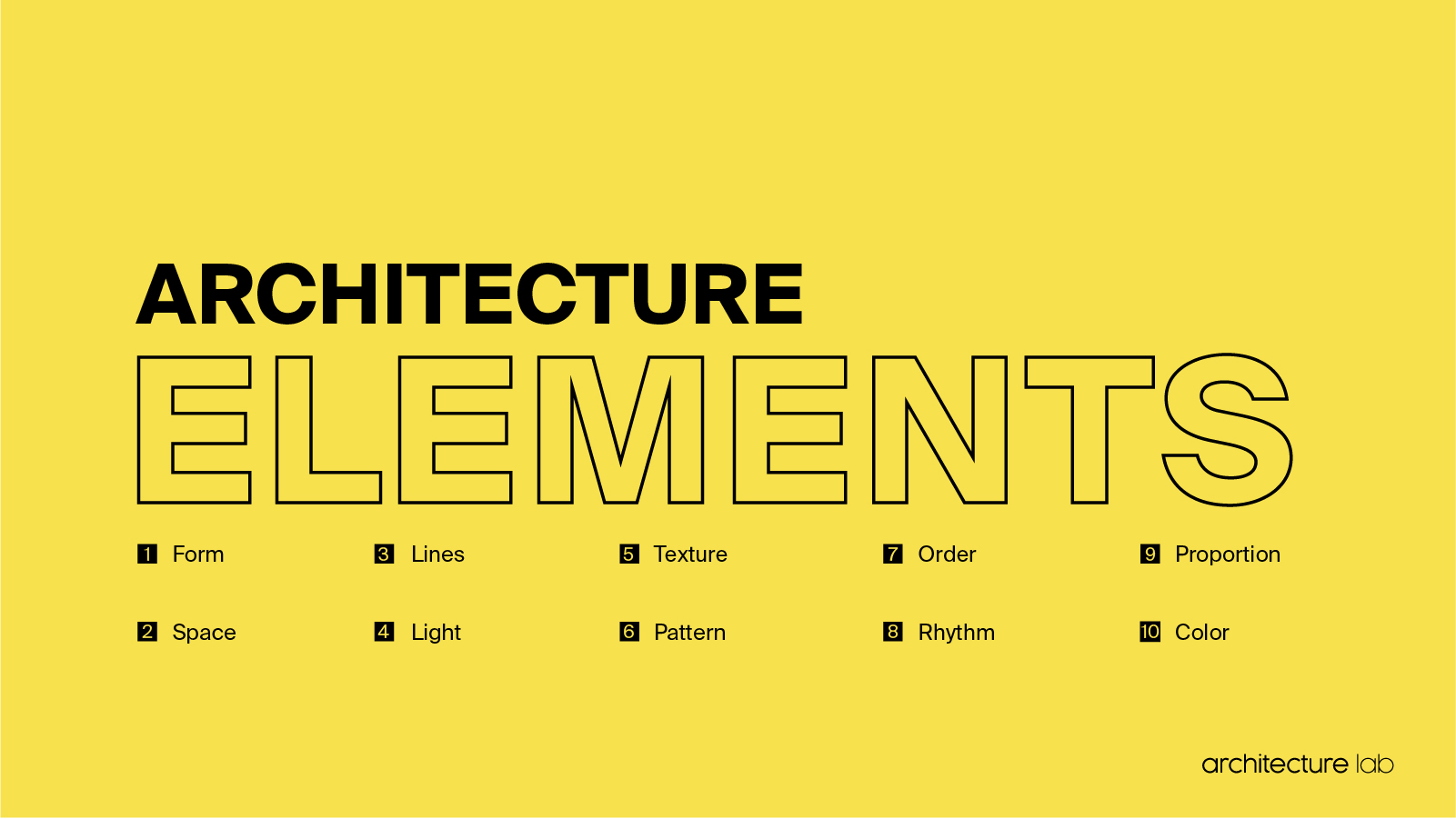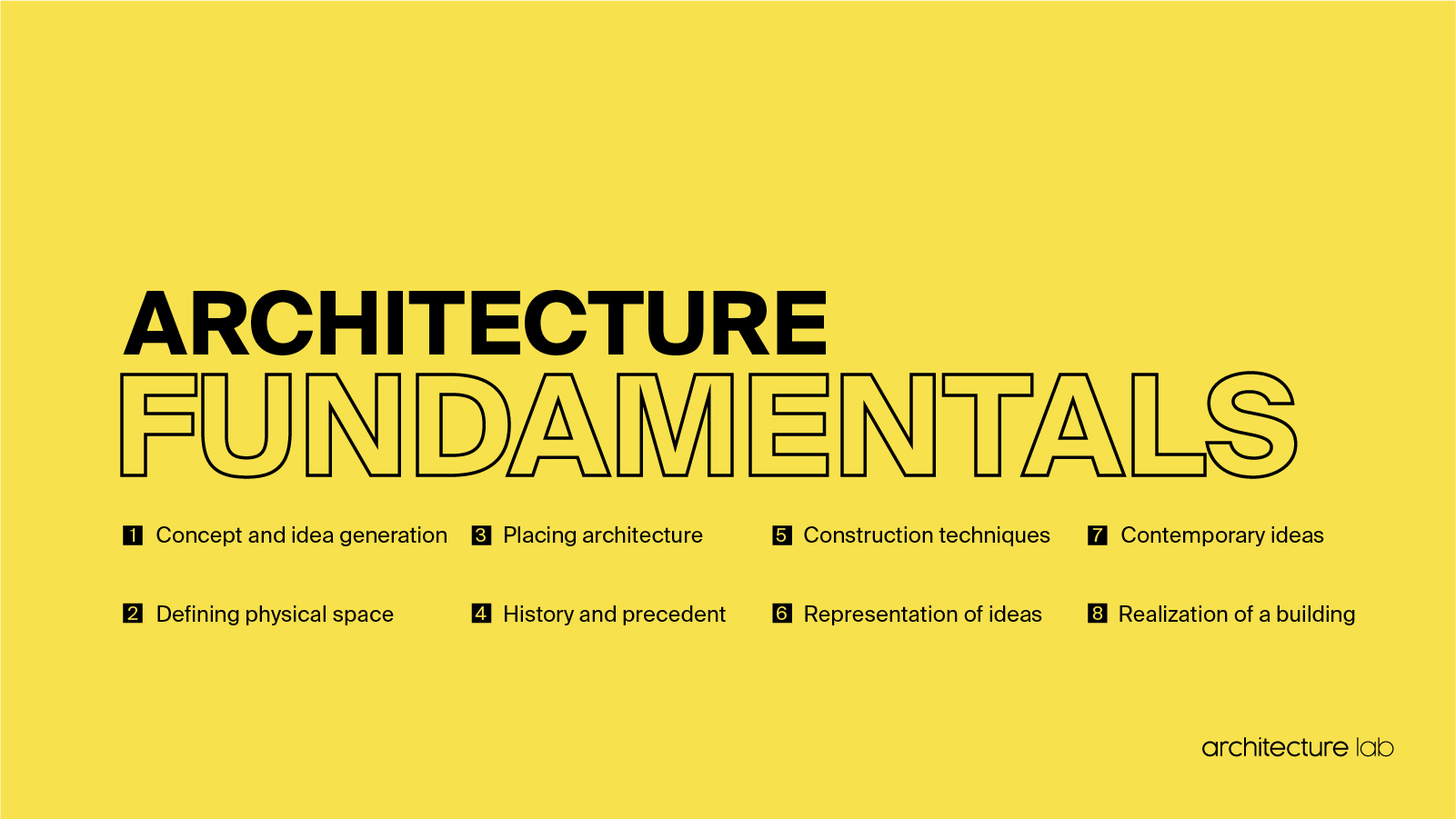
Architecture fundamentals encompass various concepts and practices essential to the field. The process starts with concept and idea generation, where architects explore different design possibilities through various techniques like site analyses, spatial adjacency matrices, case studies, sketching, and model-making, considering client needs and aspirations. Defining physical space is central, focusing on tangible, three-dimensional areas within a structure and considering aspects like zoning, circulation, and spatial hierarchy. Placing architecture involves integrating a building within its physical and cultural context, emphasizing sensitive site response. The study of architectural history and precedent informs contemporary practice by providing context and inspiration. Understanding construction techniques, both traditional and innovative, is crucial for realizing designs while representing ideas through various mediums is key to conveying design concepts. Contemporary architectural ideas push the boundaries of innovation with innovative concepts and technologies. The realization of a building marks the culmination of the design process, integrating various specialists’ work. Responding to the client and fulfilling the design brief is vital, ensuring all project elements align with client aspirations and requirements. Central pillars of architecture include form, functionality, lighting, scale, harmony, context, sustainability, and innovation. These elements and principles are interlinked, influencing and informing the others, resulting in cohesion and function. Lorraine Farrelly’s prominent role in architecture fundamentals is captured in her widely acclaimed book, “The Fundamentals of Architecture.” Farrelly’s work is particularly valued for its accessible language and clear layout, making it an indispensable resource for students and educators to understand architecture’s core elements. The book’s use in undergraduate programs and its focus on linking theory with practice further underscore its significance in the field. Additionally, several other foundational texts are critical in studying architecture fundamentals. Le Corbusier’s “Towards a New Architecture” is a seminal work advocating for modern architecture and critiquing traditional customs, emphasizing design adapted to 20th-century lifestyles. Matthew Frederick’s “101 Things I Learned in Architecture School” offers concise, fundamental lessons in an easily digestible format, ranging from basic drawing techniques to complex design principles. Francis D.K. Ching’s “Architecture: Form, Space, and Order” introduces the basic vocabulary of architectural design, using historical and cultural examples to illustrate key concepts. Kevin Lynch’s “The Image of the City” delves into urban design and the psychology of how people perceive and navigate urban environments. Christopher Alexander’s “A Pattern Language” presents patterns for creating functional built environments rooted in participatory design processes and traditional practices. Juhani Pallasmaa’s “The Eyes of the Skin” critiques the visual bias in architecture, advocating for a multi-sensory approach. Lastly, Rem Koolhaas’s “Delirious New York” explores the unique architectural landscape of 20th-century Manhattan, highlighting the interplay between artistic vision and commercial realities.

1. Concept and idea generation
Concept and idea generation is a fundamental of architecture, referring to the creative process of formulating initial design ideas. Before putting pen to paper on technical drawings, architects engage in an open-ended thinking process to imagine a wide array of possibilities for a site and program. This conceptualization phase gives form to developing ideas, allowing exploration unconstrained by practical limitations. Before further developing the details, multiple concepts are developed, compared, and refined to determine an optimal approach to responding to the client’s needs and aspirations.
Idea generation utilizes various techniques to ignite the architectural imagination. Common starting points include site analyses examining spatial context and physical attributes that could inform the design. Spatial adjacency matrices analyze ideal functional connections between programmatic spaces. Case studies research precedents and typologies related to the building type, revealing potential form strategies. Sketching and model-making encourage quickly iterating through ideas without getting bogged down in specifics. Concept diagrams abstract the essence of an approach into simple, graphic representations conveying organizing ideas. Thought experiments impose hypothetical conditions to uncover unconventional possibilities. Discussions with clients, consultants, and stakeholders spark new insights through an exchange of perspectives.
2. Defining physical space
Physical space is fundamental in architecture, referring to a structure’s tangible, three-dimensional area. It encompasses all the building’s rooms, hallways, courtyards, and other spatial volumes. Defining and organizing physical space is central to architectural design, as it directly impacts how people will utilize and experience a structure. When designing physical space, architects carefully consider zoning, circulation, hierarchy, and flexibility. Zoning involves dividing a building into distinct functional zones or areas such as living spaces, bedrooms, kitchens, etc. Effective zoning creates logical adjacencies between related spaces and separates public and private rooms. Circulation refers to the paths and routes people take to move through a building, which architects orient through spatial sequencing and visual connections.
Physical space also helps define the exterior form and morphology of a building. Manipulating spatial boundaries allows architects to create unique building forms and silhouettes. Physical space impacts the feeling and atmosphere within a structure. Qualities like spaciousness, enclosure, lighting, materials, and geometry shape the experiential qualities of inhabiting architectural space. Considering how users experience and interact with physical space is crucial for architects to design environments that support comfort, functionality, and human activity. Defining and coordinating physical spaces is thus an essential architectural skill underlying all aspects of building design.
3. Placing architecture
Placing architecture refers to carefully considering and integrating a building within its context. This encompasses both the physical site and the broader social, cultural, and environmental settings. As a core fundamental in architecture, placing considers how to situate a structure to respond sensitively to its location. When identifying a building, architects analyze the existing features of a site, including its topography, vegetation, climate, and orientation to sunlight or views. This informs strategies for embedding the architecture harmoniously within the landscape. For example, a sloping site could allow a structure to be subtly nestled into a hillside. Existing trees on site provide cues for landscaping that blends old and new.
Placing architecture also examines how to orient openings, overhangs, and massing to respond to solar or wind patterns. Beyond physical attributes, placing evaluates the historical and sociocultural dimensions of context. Architects study how surrounding buildings are situated and organized, often aligning their projects to respect existing spatial alignments, sight lines, or street edges. Research into neighborhood character, demographics, and needs is conducted to integrate appropriately. For instance, placing may involve configuring inviting public spaces to catalyze community interaction.
4. History and precedent
Studying architectural history and precedent is fundamental, providing important context and inspiration for new design. Architectural styles and movements have evolved over centuries, shaped by cultural beliefs, technological innovations, environmental responses, and artistic visions. By analyzing seminal works across eras, architects gain crucial perspectives on the underlying philosophies that drove form-making in the past. Understanding this lineage allows architects to draw from collective wisdom, adapt successful design strategies, and create an architectural language rooted in its lineage.
History and Precedent studies thoroughly examine existing structures to reveal the key ideas embodied in their composition. This includes analyzing formal qualities like massing, geometry, circulation, materiality, and spatial experience. It also entails studying the cultural narratives, environmental factors, and programmatic needs that inform the design. Such comprehensive precedent research reveals the many forces that shape architecture, which architects must synthesize in their practice. Precedent principles guide organizing space, movement, and light for site-specific contexts. They demonstrate material applications and structural solutions across building types.
5. Construction techniques
Construction techniques are a vital component of architecture fundamentals, encompassing the methods, materials, and processes used to erect buildings physically. Architects must comprehend both traditional and innovative techniques to realize their designs effectively. Studying seminal construction methods across history reveals the interplay between available materials, tools, labor skills, and cultural beliefs in shaping buildings. Architects understand how stoneworking, timber framing, and concrete forming have evolved, informing material choices and structural possibilities today. Examining vernacular building traditions highlights how local climate, resources, and needs can inform regionally attuned, sustainable designs.
Construction techniques are crucial for architects practicing in an era of rapidly advancing technologies. Prefabrication, modular building, 3D printing, and robotic assembly are revolutionizing construction, enabling unprecedented formal expressions, speed, precision, and waste reduction. Architects must stay abreast of these techniques’ capabilities and limitations to leverage their potential fully. Understanding assembly sequences and tolerances allows contractor coordination for buildable, efficient designs. Technological innovation continues, and traditional hand tools and methods remain essential architectural knowledge. Mastering the fundamentals of material manipulation empowers architects to thoughtfully select finishes and detail junctions where quality craftsmanship profoundly impacts spatial experience. Construction knowledge further enables architects to specify measures ensuring structural integrity, moisture protection, and thermal comfort.
6. Representation of ideas
Representation of ideas is a core architecture fundamental that refers to the various methods architects use to convey design concepts. This involves creating drawings, models, renderings, animations, and other media to communicate design intent. Representation transforms an idea in the mind into a shareable format that others can understand, critique, and construct. Architectural representations must balance artistry, abstraction, and technical precision. Some typical architectural representations include sketches, diagrams, plans, sections, elevations, axonometric and perspective drawings, physical and digital models, animations, and renderings. Illustrations loosely initial design concepts using simple lines and shapes. They capture fleeting ideas without getting bogged down in details. Diagrams abstract the essence of a design using symbols and graphic elements. Plans, sections, and elevations document technical drawings’ exact spatial configurations and relationships.
Architectural representation aims to visualize the finished building before it is built. It is both an act of creation and problem-solving, allowing the testing of ideas without real-world consequences. Representations facilitate critique from clients, users, builders, and code officials. They also aid in the coordination of consultants like engineers and contractors. Clear, accurate representations are thus vital for architecture to be realized. Physical models made of paper, wood, 3D prints, etc., allow tangible study of forms. Digital models generated in modeling software enable dynamic viewing, lighting studies, and photorealistic renderings.
7. Contemporary ideas
Contemporary ideas are core fundamentals in architecture that refer to innovative concepts, technologies, and design approaches that push the boundaries of building design in the present day. Instead of relying solely on past precedent, incorporating contemporary ideas allows architecture to be forward-thinking and responsive to current needs and possibilities. This often involves challenging norms, traditions, and assumptions to create novel solutions. Some contemporary ideas shaping architecture today include parametric and algorithmic design, computational optimization, advanced fabrication methods like 3D printing, adaptive and kinetic structures, biomimicry, and sustainability-focused strategies. Parametric design uses computer algorithms to dynamically manipulate building parameters, creating complex, performative geometries tailored to unique contexts. Computational optimization leverages AI and machine learning to efficiently iterate design options, balancing cost, energy use, daylight, and spatial adjacencies. Digital fabrication translates advanced 3D models directly into constructible building components.
Contemporary ideas drive architecture’s ongoing evolution. It incorporates moving elements to adapt spaces in response to users and environments. Biomimicry emulates natural forms, systems, and processes found compelling through evolution—sustainable strategies like passive heating/cooling, intelligent materials, and net zero energy target ecological regeneration. By incorporating forward-looking contemporary ideas, architects can create genuinely innovative structures not bound by the past. Contemporary architecture challenges norms around form, function, meaning, and technology in the built environment. It is often controversial initially, as people must adjust their conceptions and expectations of what buildings can be. But today’s provocative contemporary architecture can reshape our collective understanding of buildings and cities over time.
8. Realization of a building
Realization of a building encompasses the actual construction and materialization of architectural designs into physical, inhabited structures. It marks the culmination of the design process as drawings, models, and renderings transition from abstract representations into tangible built forms. Fundamental to architecture is understanding the complex process of embodiment – of imagined spaces becoming experiential realities. Realization integrates numerous specialists across fields like engineering, construction, project management, law, and more to coordinate the meticulous assembly of buildings. Architects guide the translation of their creative vision through detailed technical drawings, specifying spatial configurations, materials, finishes, fixtures, and construction sequences.
Throughout realization, architects monitor the work, approving shop drawings, solving problems, and ensuring conformance to design intent and quality standards. They conduct site observations and consultations to verify construction details, review product samples and mockups, assess workmanship, and recommend corrections when needed. It is essential that architects intimately understand the techniques, limitations, and sequencing of building systems to facilitate smooth project coordination. These documents enable collaborating engineers to ensure structural integrity and building performance. General contractors then organize the on-site construction, coordinating specialized subcontractors and sourcing equipment and materials.
9. Client response and brief fulfillment
Responding to the client and fulfilling the design brief are core fundamentals of architectural practice. The brief encapsulates the client’s requirements, budget, schedule, site parameters, program, and goals for the project. Architects must comprehend the brief completely to translate aspirations into buildable, inhabitable forms. From initial meetings and interviews, architects actively listen and probe to fully grasp the client’s values, aesthetics, functional needs, and vision for the project. This empathy and insight shape conceptual designs explicitly tailored to the client. Presenting ideas, sketches, and feedback models refines the design through an iterative dialogue, ensuring it aligns with expectations. Architects remain open to criticism, avoiding personal attachment to any one scheme.
Settling on a design direction, architects ensure that all elements – from overarching concepts to minute material details – fulfill the intentions outlined in the brief. Zoning analyses confirm the design complies with site regulations. Accessibility consultants verify equitable ingress/egress. Engineers size structural and mechanical systems to support programmatic functions. Estimators continually gauge cost feasibility compared to budget. The design progresses via a matrix of performance benchmarks rooted in the mandates of the brief. Throughout construction, architects monitor progress to guarantee adherence to the brief. They review product samples, mockups, shop drawings, and installation methods, approving only those that meet quality and performance criteria. Where necessary, they issue supplementary documentation to resolve unforeseen conditions or changes.
What are the most important pillars of architecture?

Listed below are the most important pillars of architecture:
- Form: The form of a building refers to its overall shape, proportions, geometry, and volume. The form gives visual character and aesthetic appeal. It encompasses the building’s massing, silhouette, rhythm, symmetry, and balance, making it an important pillar of architecture. It should complement and enhance the intended function. Simple forms tend to appear more elegant and timeless. Complex forms may seem visual but risk appearing dated later. Form impacts how natural light enters a space. Curved forms soften light, while angular forms create distinct light patterns. The form also affects acoustics and heat gain/loss. Architects consider context, intended use, sustainability, functionality, aesthetics, and more in designing form.
- Functionality: Functionality refers to how well its spaces, layouts, and features serve intended uses and activities. Good functionality promotes efficient circulation and logical adjacencies between areas based on their relationships. It provides appropriate room sizes/proportions for their functions. Elements like stairways, hallways, entrances, and storage. Flexibility and adaptability allow modifying spaces for evolving uses. Durability of finishes handles expected wear. Proper lighting, acoustics, ventilation, utilities, and technologies support functions. Architects in accessibility accommodate users of all physical abilities. Optimizing daylight, views, and indoor-outdoor connections further enhances functionality.
- Lighting: Lighting is foundational to architecture, enabling the use of interior spaces and influencing the atmosphere. Adequate lighting interweaves natural and artificial light. Thoughtful fenestration placements balance light distribution. Solar orientation informs window sizing/shading to leverage daylight while preventing overheating. Lighting design considers the interplay of direct, indirect, and ambient lighting. Layers of light combine general ambient illumination and localized task lighting. Contrast creates visual interest and highlights architectural forms. Dynamic lighting scenarios match lighting qualities to functions. Controls offer personal adjustment options. Architects use lighting as a sustainability factor, including using efficient fixtures/bulbs and integrating lighting with HVAC and building automation systems.
- Scale: Scale is an architectural fundamental that refers to the relative size of a building and its elements relative to human proportions. Interior space sizes relate to typical furniture and needed movement within. Structural bays, fenestration patterns, and ornamental details correspond to the overall size. A scale aligns the building massing with its site and context. Large or small-scale buildings often look out of place, creating a disruptive visual contrast. More significant buildings can feel imposing and cold due to long travel distances. A tiny scale makes occupants feel confined. The scale also impacts residents’ sense of community, ownership, and stewardship of their buildings.
- Harmony: Harmony in architecture is fundamental, combining building elements into a visually coherent, balanced whole. Harmony arises from consistently using forms, geometries, proportions, rhythms, symmetries, materials, colors, textures, lighting, and ornamentation. Harmonizing with the surrounding landscape and existing buildings further strengthens the composition. Strong harmony typically features an explicit order by repeating elements with minor controlled variations to add visual interest. Harmony does not necessarily mean uniformity—contrasts often highlight and reinforce the ranking.
- Context: Context includes its surrounding landscape, landforms, vegetation, climate, urban fabric, infrastructure, history, and culture. Context-sensitive architecture carefully considers environmental factors in the siting and orientation. Forms, materials, and construction techniques suit the regional climate and hazards. Historical references and vernacular elements respect cultural traditions while allowing contemporary interpretation. Style and proportions acknowledge nearby architectural precedents without crude imitation. Landscaping and public spaces transition between private and community realms. Infrastructure upgrades improve neighborhood livability.
- Sustainability: Sustainable architecture holistically minimizes environmental harm from construction, operations, and eventual demolition. Site selection and efficient plans avoid unnecessary development footprint. Durable, non-toxic materials conserve embedded energy and resources while promoting healthy indoor air quality. Passive heating/cooling, solar energy, natural ventilation/lighting, rainwater harvesting, and native landscaping reduce resource consumption. Denser development preserves habitat and farmland while enabling walkable lifestyles. Adaptive reuse repurposes existing structures. The design for deconstruction allows the reuse of salvaged components after demolition. Sustainability requires a life cycle assessment of all architectural choices, not just visible elements.
- Innovation: Innovation reimagines built environments to better serve evolving cultural needs and construction capabilities. Innovation advances techniques, technologies, materials, forms, and spatial quality. Visionary design concepts establish new paradigms adapting to shifting demographics, family structures, work patterns, transportation modes, and environmental awareness. Some innovations improve efficiency and sustainability incrementally, while radical innovations enable new building typologies. Historic innovations allowing wide-spanning structures, modern concrete and steel construction, electricity, elevators, and HVAC technologies transformed architecture fundamentally.
What are the most important elements of architecture?

Listed below are the most important elements of architecture:
- Form: The form of a building refers to its shape and volume. The form gives visual character and aesthetic appeal through the building’s massing, silhouette, geometry, symmetry, and balance. The elements in form are simple and appear more timeless, while complex forms risk visual dissonance. The form impacts natural light patterns, heat gain/loss, acoustics, and function. Architects consider context, intended use, sustainability, functionality, and aesthetics in designing form to create geometric order and visual logic.
- Space: Space refers to the interior volumes and layouts that occupants inhabit. Spatial design provides appropriately sized spaces for intended functions. It enables efficient circulation between spaces based on their relationships. The architecture element of space measures the qualitative experiential qualities shaped by form, light, materials, views, natural connections, and context. Spatial sequences moving through different rooms offer dynamic experiences. Flexible spaces accommodate evolving uses. Spaces promote specific social interactions, ownership, and community identity.
- Lines: Lines in architectural elements refer to edges and outlines defining forms, spaces, and circulation. Structural framework lines divide a building into rhythmic bays. Silhouettes and skyline profiles become distinctive lines characterizing structures. Visual lines, such as floor and wall planes, also arise where materials meet. Lines direct occupant views and movement. Horizontal lines suggest stability and connection to the earth, while vertical lines reach aspirationally towards the sky. Lines communicate design logic and hierarchy through visual emphasis.
- Light: Light enables occupants to see and inhabit interior spaces while deeply affecting the atmosphere. Adequate lighting interweaves daylight and electric light sources. Fenestration placements balance light distribution while leveraging and controlling daylight. Artificial lighting supplements where daylight is absent. Lighting design considers direct, indirect, ambient, and task lighting through fixtures, reflectors, and controls to match lighting qualities to functions.
- Texture: Textures add tactile and visual richness through surface characteristics. Coarse textures like stone and rough concrete feel and appear fundamentally different from smooth textures like polished metals and glass. Natural wood exhibits fine yet directional textures reflecting growing patterns. Some textures deliberately reveal construction methods and material origins, while others disguise assemblies through consistent finishes. Contrasting textures communicate the hierarchy of spaces and surfaces. Textures influence acoustics and light reflections. Occupants experience textures directly through touch or observation from afar.
- Pattern: Patterns organize architectural elements into visually rhythmic arrangements through repetition and variation. Patterns may feature geometric shapes, forms, textural details, ornamentation, or structural bays distributed across buildings. Certain designs reflect traditional practices, while others represent cultural meanings. Patterns help break down larger masses into smaller, understandable scales. They establish order through underlying rules that allow some variability without chaos. Distinct patterns define individual spaces, while unified practices reinforce collective identity.
- Order: Order in architectural elements refers to the logical visual relationships between elements conveying deliberate design intent. Order arises from the consistent application of forms, geometries, proportions, symmetries, grids, hierarchies, patterns, sizes, placements, groupings, etc. Order need not imply historical revival styles; Modernism exemplifies order through functional clarity. Architects avoid appearing disordered and arbitrary, no matter how many components may be.
- Rhythm: Rhythms add a visual tempo through alternating repetition of architectural elements. Regular rhythms feature consistent intervals between elements like columns or structural bays, whereas subtle accelerating/decelerating rhythms imply visual momentum. Rhythms distinguish otherwise monotonous surfaces with kinetic vitality akin to music. Rhythmic compositions guide occupants’ eyes and bodies through spaces fluidly. Rhythms work with other ordered patterns across scales, from ornamental details to overall massing.
- Proportion: Proportions refer to the dimensional ratios between building elements, spaces, and whole buildings. Proportions employ geometry derived from nature, simple integer ratios, and historically established precedents. Classically ordered architecture codified strict proportional systems. Proportions also anchor buildings to human scale through ergonomic sizes familiar to bodily movement and sightlines. Spaces feel more comfortable and understandable when proportions align with human proportions. Proportional systems provide continuity across scales, from urban patterns to construction details.
- Color: Color affects spatial qualities and architecture’s emotional impact. Natural materials exhibit inherent colors, while coatings and pigments introduce color to otherwise neutral materials. Color choices tie back to design intentions, balancing function, and visual enrichment. Colors delineate architectural zones and elements. Contrasting colors accentuate compositional tensions. Coordinated color schemes project harmony through cultural associations. Light and weather conditions continually modify perceived colors.
How are the architecture fundamentals connected to each other?

Listed below are how architecture fundamentals are connected:
- Concept and idea generation to define physical space: The initial design concept and ideas guide how physical spaces are defined and organized. Abstract ideas about intended uses, spatial qualities, and architectural expressions established during conceptual design are translated into practical layouts specifying room sizes, adjacencies, and relationships.
- Defining physical space-to-place architecture: The arrangement of physical spaces directly shapes the site’s building placement and orientation options. Spatial definitions consider exterior factors like sunlight, views, noise, and accessibility, which determine optimal building placement.
- Placing architecture to history and precedent: Design decisions regarding architecture placement require understanding the historical and cultural context of the site, including vernacular building patterns and orientations. Knowledge of precedents ensures new interventions properly acknowledge heritage value while allowing contemporary interpretations.
- History and precedent to construction techniques: The choice of structural systems, materials, and construction techniques is informed by past precedents regarding availability, structural logic, climate suitability, and cultural traditions. Historical solutions may be adapted using modern engineering tools and material innovations to respect heritage while advancing efficiency.
- Construction techniques for representation of ideas: The techniques and media used to represent architectural ideas must align with chosen construction methods and materials to accurately convey scale, structure, textures, spatial qualities, user experience, lighting, etc. Representational skills, tools, and standards co-evolve with construction innovations.
- Representation of ideas to contemporary ideas: Representation methods reflect current architectural concepts and technologies. Hand drawings capture ideas differently than BIM models. Conventions in architectural visualizations shift alongside prevailing schools of thought driving innovations.
- Contemporary ideas to realization of a building: Contemporary architectural thought and discourse guide priorities in overall decision-making to ensure buildings remain relevant. Ideas around sustainability, contextualism, spatial experience, etc., shape practical choices in realized buildings within limitations.
- Realization of a building to client response and brief fulfillment: The degree to which the completed building matches the original client brief and elicits positive user response validates the cumulative design process. Real-world performance data further informs professionals and future projects to incrementally advance architecture.
Who is the most important person to document architecture fundamentals?
The most important person for documenting the architecture fundamentals is Lorraine Farrelly. She authored the book “The Fundamentals of Architecture,” covering architecture’s basics and core ideas. The product descriptions for her book highlight that it explores the architectural design process from initial concepts through to realization, encompassing site context, representations, techniques, contemporary ideas, and more. Architects commended the book’s accessible language, clear layout, images, and recent examples of effectively communicating concepts to students. Given the focus on fundamentals in the title and the book’s recommendation for that new study of architecture, it is evident that Lorraine Farrelly has created an authoritative foundation-level survey text documenting the core elements comprising architecture. Her emphasis on connecting theory to practice provides essential linkages in the material. The fact that The Fundamentals of Architecture is already in use in undergraduate architecture programs and has been updated to a second edition further supports its prominence as a seminal pedagogical guide outlining architectural fundamentals. It appears well-regarded among academics for its utility in architecture education.
What are the most important books about architecture fundamentals?
Listed below are the most important books about architecture fundamentals:
- Towards a New Architecture: Towards a New Architecture is a seminal 1923 book by influential architect Le Corbusier that advocates for modern architecture fundamentals through a collection of essays. Originally published in French, it promotes contemporary design adapted for 20th-century lifestyles, made possible by new construction techniques and materials. The book argues that by using raw materials, architecture should go beyond mere utility to create emotional relationships. It criticizes stagnant customs and calls for industry and mass production. With over 200 illustrations of Corbusier’s works, this manifesto outlines his technical theories on form, function, and machine aesthetics, laying the groundwork for a generation of modernist architects.
- 101 Things I Learned in Architecture School: 101 Things I Learned in Architecture School by Matthew Frederick is a 2008 book that provides 101 concise lessons that cover fundamentals for architecture students and practitioners. From basic concepts like drawing lines to complex topics like color theory, the content is presented through unique illustrations and explanations on two-page spreads. It teaches step-by-step architectural drawing, design, presentation, and visualization techniques. The book encourages critical thinking about principles students must master, with witty examples and simple language to demystify murky concepts.
- Architecture: Form, Space, and Order: Architecture: Form, Space, and Order by Francis D.K. Ching is an essential textbook. This 1979 book introduces the basic vocabulary of architectural fundamentals through illustrated chapters. Using examples across history and cultures encourages critical thinking about how form and space are ordered in the built environment. Concepts covered include structure, space, light, views, circulation, proportion, scale, and the relationship between buildings and contextual sites. Figures demonstrate constructing three-dimensional forms using points, lines, planes, and volumes. Breaking down fundamentals promotes understanding principles that underlie architecture’s role in creating experiential, functional spaces.
- The Image of the City: The Image of the City by Kevin Lynch is a highly influential 1960 book that examines architectural fundamentals on how people perceive and navigate urban environments. Through 1950s empirical studies in Boston, Jersey City, and Los Angeles, Kevin Lynch identified five key elements that shape mental maps of cities: paths, edges, districts, nodes, and landmarks. He emphasized designing legible cities that resonate with inhabitants by creating memorable forms. Lynch pioneered ideas about environmental imageability and wayfinding, establishing his reputation and legacy in urban planning and design.
- A Pattern Language: A Pattern Language by Christopher Alexander is a 1977 book that presents 253 architectural fundamentals, planning, and construction patterns for creating livable, functional built environments, ranging from regional planning down to small details. The patterns promote a participatory, iterative design process rooted in traditional practices. Part of Alexander’s larger body of work on pattern languages and living structure, it provides an essential counterpoint to modernist design critiques. The book connects readers to timeless wisdom and continues to influence architects and planners today.
- The Eyes of the Skin: The Eyes of the Skin by Juhani Pallasmaa is a classic 1996 book that critiques the visual bias in architecture fundamentals, arguing that reliance on ocularcentrism aesthetics often diminishes buildings’ multi-sensory spatial and existential potential. Pallasmaa calls for an architecture of the senses created through phenomenological and haptic material experiences, especially touch, smell, taste, and sound. His ideas have been profoundly influential, translated into numerous languages, as part of a movement to counteract modernism’s suppression of bodily perceptions.
- Delirious New York: Delirious New York by Rem Koolhaas is a 1978 book that explores the surreal density and diversity of Manhattan’s 20th-century architectural fundamentals. Koolhaas celebrates the chaotic manifestations emerging from the friction between artistic vision and pragmatic commercial forces in the city. The book’s graphic novel-like illustrations and experimental writing style convey his retroactive “Manhattanism” manifesto, revealed through chapters on crucial New York figures like the Guggenheim. It established urban hybridity and congestion ideas, defining his early thinking and legacy.
Discover more from reviewer4you.com
Subscribe to get the latest posts to your email.




